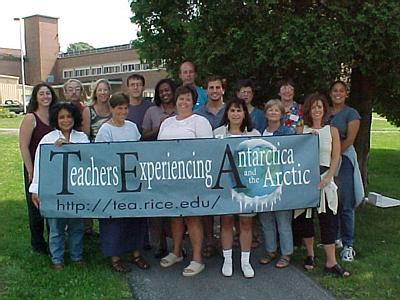9 August, 2000
TEA Orientation- Day Three
Overview
I am writing from the Cold Regions Research and Engineering Lab (CRREL)
in Hanover, New Hampshire surrounded by a remarkable group of
researchers, educators and scientists from around the country. The
level of commitment involved in polar research is extraordinary. Of the
sixteen teachers here, eight of us will be going to the Arctic, and
eight to the Antarctic. So far, we have no idea which projects we will
be working on but I am looking forward to the experience of working in
the Arctic as part of a scientific research team. What a remarkable
opportunity!
What do you wear?
We have had a chance to see some of the Extreme Cold Weather (ECW) gear
that makes living in a polar environment possible. It is not unusual to
work for 12 to 18 hours a day and much of that time could be outside on
the ice collecting samples, conducting experiments or maintaining very
valuable instruments. Nights may be spent sleeping in tents on the ice.
Weather conditions can change from hour to hour. The sun may be shining
24 hours a day, but temperatures can easily reach -20 degrees
Fahrenheit, which is even more extreme in wind conditions.
The opportunity to conduct research in the Arctic and Antarctic
In remote areas many of the things that we take for granted may not be
available.

Here are the future Arctic explorers at Orientation!

Here you see Dena modeling the latest Extreme Cold Weather parka (ECW) in sunny New Hampshire.

Summer 2000 TEA Orientation at the Cold Regions Research and Engineering Lab (CRREL).
Contact the TEA in the field at
.
If you cannot connect through your browser, copy the
TEA's e-mail address in the "To:" line of
your favorite e-mail package.
|
